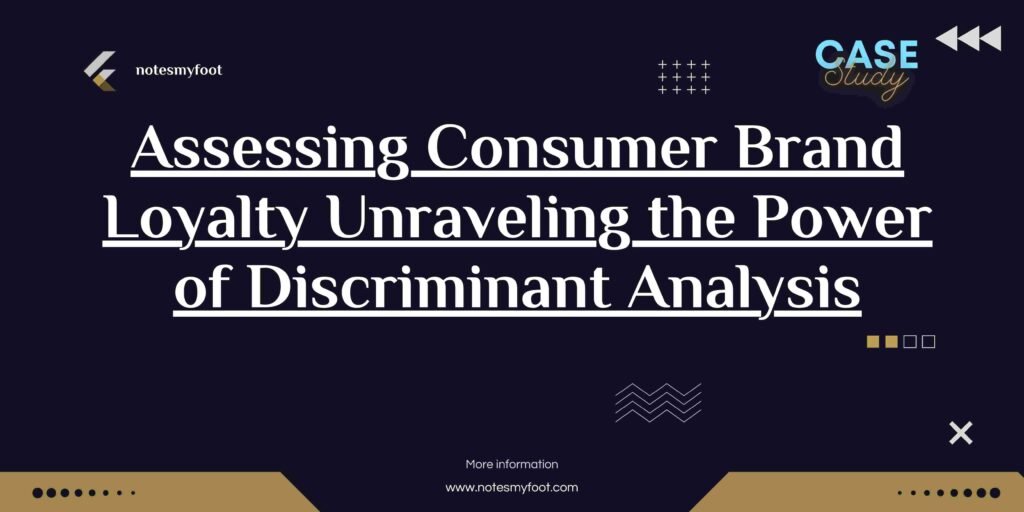
Case study of Power of Discriminant Analysis
Assessing brand loyalty is a critical aspect of understanding consumer behavior and making informed business decisions. In this blog post, we will delve into the intricacies of brand loyalty assessment, focusing on the Discriminant Analysis (DA) technique and its relationship with regression analysis. By the end of this post, you will gain valuable insights into the steps involved in DA, the role of Multiple Discriminant Analysis (MDA), and how to effectively analyze and interpret data to make informed decisions.
Industry Overview:
Before diving into the assessment of brand loyalty, it is crucial to grasp the broader context of the industry. Understanding the competitive landscape, market trends, and consumer preferences will provide a solid foundation for brand loyalty assessment. By staying informed about industry dynamics, businesses can effectively position their brands and develop strategies that resonate with their target audience.
About SKM:
To illustrate the concepts discussed in this blog post, let’s consider a hypothetical scenario involving SKM, a leading consumer goods company planning to launch a new product line. SKM aims to assess the brand loyalty of its existing customers to understand their preferences and tailor its marketing efforts accordingly.
Preparing for the Launch:
Before diving into brand loyalty assessment, it is essential for SKM to conduct thorough marketing research. This research should encompass various factors such as consumer satisfaction, brand perception, and purchase behavior. By gathering relevant data, SKM can identify patterns and trends that shed light on customer loyalty.
The Power of Discriminant Analysis:
Discriminant Analysis (DA) is a powerful statistical technique used to assess the relationship between a dependent variable (in this case, brand loyalty) and various independent variables (such as consumer satisfaction, marketing efforts, etc.). By employing DA, businesses can unveil the underlying factors that significantly impact brand loyalty and devise strategies to enhance it.
Unleashing the Steps in DA:
Discriminant Analysis (DA) is a powerful statistical technique used to assess the relationship between a dependent variable (in this case, brand loyalty) and various independent variables (such as consumer satisfaction, marketing efforts, etc.). By employing DA, businesses can unveil the underlying factors that significantly impact brand loyalty and devise strategies to enhance it.
Unleashing the Steps in DA:
To conduct DA effectively, several steps must be followed. Firstly, data collection is crucial, as it provides the foundation for analysis. Next, variables that are most predictive of brand loyalty are identified through variable selection techniques. Subsequently, a discriminant function is developed, which helps classify customers into different loyalty categories based on their responses to the identified variables.
The Relationship between DA and Regression:
While DA focuses on classification, it is important to highlight the relationship between DA and regression analysis. Regression analysis helps identify the strength and direction of the relationship between the dependent variable (brand loyalty) and independent variables (consumer satisfaction, marketing efforts, etc.). By understanding this relationship, businesses can gain deeper insights into the factors driving brand loyalty
The Role of Multiple Discriminant Analysis (MDA):
In certain scenarios, businesses may encounter multiple groups within their customer base. This is where Multiple Discriminant Analysis (MDA) comes into play. MDA allows for the assessment of brand loyalty across different customer segments or groups. By employing MDA, businesses can uncover unique insights into each group’s loyalty drivers and tailor their strategies accordingly.
Analyzing and Interpreting Data:
Accurate data analysis and interpretation are crucial to derive meaningful insights from brand loyalty assessments. By employing statistical software and techniques, businesses can analyze the discriminant function’s results, examine the significance of variables, and understand their impact on brand loyalty. This enables informed decision-making and the formulation of targeted strategies.
Conclusion:
In conclusion, assessing consumer brand loyalty is a complex task that requires a deep understanding of statistical techniques such as Discriminant Analysis. By leveraging the power of DA, businesses like SKM can gain valuable insights into the factors driving brand loyalty, identify customer segments, and tailor their strategies accordingly. By employing rigorous data analysis and interpretation, businesses can make informed decisions that foster brand loyalty and propel their success in the marketplace. Also get to know about Mercedes-Benz India: Approach to Capturing a Younger Segment case study
